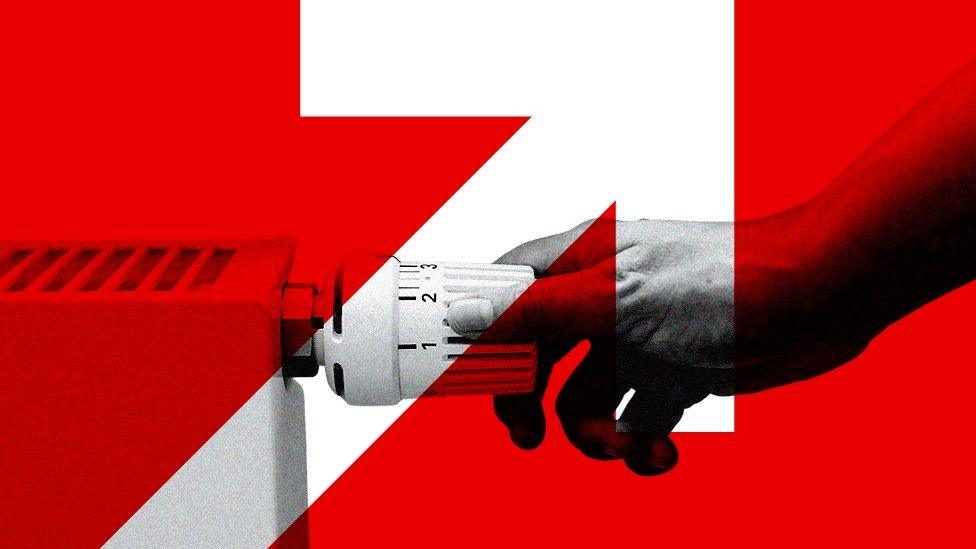Big regional divide on some energy bill charges
- Published
- comments

Jeehan Saleh and Hesham Hussain say they "weren't shocked" to hear standing charges where they live will see a big rise
Sharp rises in standing charges on standard electricity bills will see customers face very different cost increases depending on where they live.
Customers in South Scotland, Merseyside, North Wales and the South West of England will see the daily payments double from April.
Those in London and the East of England will see increases of less than 60%.
Almost all consumer bills include a standing charge; a fixed daily payment covering the costs of supply and other levies.
The regulator Ofgem caps them for consumers on standard default tariffs in England, Wales and Scotland, although the cap varies by region.
Standing charges are not the biggest part of an energy bill, but they are set to rise by more than £71 a year on average in April.
'Not surprised'
Jeehan Saleh and Hesham Hussain told the BBC the wide regional differences were unfair at time when energy bills are soaring.
They say they "weren't shocked" when they learned that standing charges where they live in Garston in South Liverpool would rise by double that of other areas.
"Surprise, surprise, Liverpool again isn't it," said Hesham.
"It's always us being hit the hardest," added Jeehan. "There's people in poorer areas where we work who are choosing between food bills and energy bills. Thankfully we're not in that position but it's not too far from home. You're already feeling it in so many areas, this is just another hit."
The standing charge has always varied depending on where you live, due to different costs to supply homes with power in rural or more remote areas.
However, BBC research has shown that the increase this spring varies disproportionately in different parts of Britain, when comparing standard variable tariffs for electricity paid for by direct debit.
Analysts told the BBC that local suppliers are moving charges which were once part of a consumer's unit price for energy (which now has a tight upper limit on it) over to their standing charge. They are also increasing standing charges to the maximum level for each region, which means a big jump for some places.
The average increase - of just under 20p per day - will add more than £71 a year to a standard electricity tariff. But in North Wales and Merseyside, the South West, the Midlands, South Scotland and South Wales the rise will add over £80 a year. In London less than £30 will be added.

The cap on standard charges will increase more in some areas than others
Price per day for Single Rate Electricity Meter from April 2022 by British region in order of percentage charge.
London: up 8p a day to 31p - a 38% increase
Eastern: up 13p a day to 36p - a 58% increase
South East: up 17p a day to 40p - a 73% increase
North West: up 17p a day to 40p - 73% increase
Southern: up 18p a day to 41p - an 80% increase
Yorkshire: up 21p a day to 46p - an 81% increase
North Scotland: up 22p a day to 48p - a 83% increase
Northern: up 21p a day to 46p - an 85% increase
East Midlands: up 20p a day to 43p - an 88% increase
Midlands: up 22p a day to 46p - a 92% increase
South Wales: up 22p a day to 46p - a 94% increase
Southern Scotland: up 24p a day to 47p - a 100% increase
South Western: up 25p a day to 49p - a 101% increase
North Wales & Merseyside: up 23p a day to 45p - 102% increase
Source: Ofgem

The changes are slightly different for customers using prepayment meters.
It comes as households in England, Scotland and Wales prepare for an even bigger hit when the energy price cap - which limits what consumer pay per unit of gas and electricity - also goes up in April.
In Liverpool, David and Joan Boyle told us their energy bill was rising by £700. They are happy they will be able to manage but say they worry about other people.
Elsewhere there was more concern.

Kev Oloughlin and his son Leo
"Standing charges should be the same everywhere shouldn't they," said Kev Oloughlin. He was enjoying a day out in the sunshine with his son Leo. He told us they'd "normally shop around every year when bills come in, but at the moment it's pointless".
He added: "We're managing alright with things but we're conscious of having the heating and things like that on. Everyone's got to tighten their belt at the minute haven't they."
The standing charge not only covers costs such network maintenance, administration fees and certain government schemes. It is also the part of your bill that will contribute to the cost of the 28 energy suppliers that have gone bust since last autumn amid a cost crunch sparked by sharply rising wholesale energy prices.
Ofgem told the BBC that the levy added to bills to pay for costs associated with energy suppliers going bust had been spread equally across the country.
It says standing charges in some regions are increasing more than others because of a reallocation of network costs, the level of which differs between distribution networks.
Unavoidable cost
The BBC contacted major suppliers British Gas, Scottish Power, EDF, EOn, Ovo/SSE, Shell, Octopus and Bulb, and almost all confirmed they now have a majority of customers on a standard default tariff, which is controlled by the Ofgem cap.
Three of the biggest suppliers, British Gas, Scottish and Ovo/SSE would not give details on their charges, calling them "commercially sensitive".
But EOn, EDF, Shell, Octopus and Bulb confirmed they were increasing standing charges on these tariffs in line with the standard charge cap, with example prices (including VAT) from Bulb, EDF and Shell varying from 32p a day in London and 38p in the East, to around 50p in Northern Scotland and the South West.
And it is not an expense that can be avoided by shopping around. While tariffs actively chosen by customers, such as fixed rate tariffs, are not subject to the default tariff cap on standard charges, there are only a handful of such deals on the market.
Moneysupermarket told the BBC that as of 14 March, there were just five fixed tariffs available to consumers. This compares to about 96 fixed deals available at the same time in 2021.


Standing charges are certainly not the biggest part of your energy bill, and they are dwarfed by the massive increases in the unit price for the energy you use.
But in normal circumstances an extra £80 a year on your energy bill just from standing charges would not go unnoticed, especially as in some areas they are increasing by a lot more than others. So is something fishy going on?
Ofgem assures me that the extra costs for failed energy companies are being spread equally across the country.
But the Energy Networks Association say that no major network developments have happened in any areas in the last six months that would explain the regional divisions.
Local suppliers are moving charges which were once part of your unit price, which now has a tight price cap on it, and shifting them across to your standing charge. Most suppliers are upping their standing charges to the maximum level for each region, which means a big jump for some places, adding insult to the injury of a whopping energy bill.
Update 18 May 2022: This article was amended to reflect the fact that some previously offered deals don't include standing charges.


WOMEN OF WALES: Showcasing amazing Welsh female talent and stories
PEOPLE THOUGHT OF AS BITS OF AN ALGORITHM: Life and death in the warehouse

- Published3 March 2022

